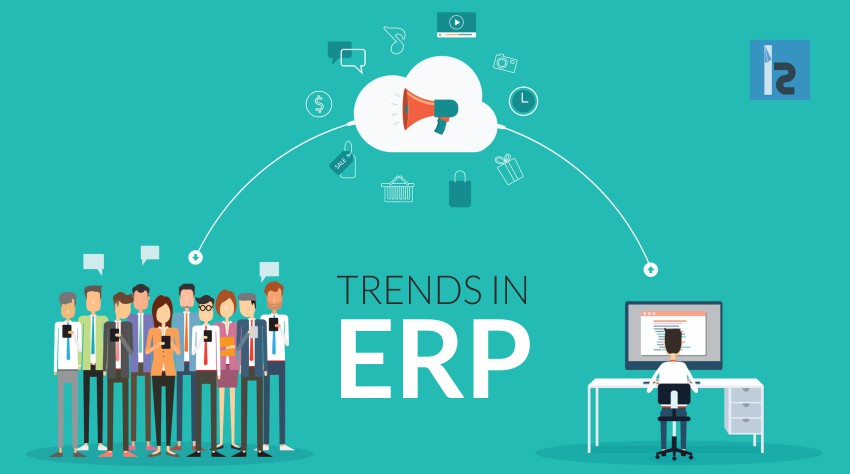The inception of INTERNET has opened up gates with numerous opportunities for personal as well as commercial use. Yet, one question do arises in every individual, how-come an interconnected computer network can bring up such a change in the world.
Unrecognizably, this medium has given a support to implementation of new technologies. Technical disruption might cause saturation in a technology but, it also offers a range of advancements and innovations. These innovations are slowly revolutionizing the traditional way of working processes in an enterprise. When it comes to business, it’s considerably important to address the implicating practice of new advancements in Enterprise Resource Planning.
ERP—a single-system which integrates all the modules required for the different core processes in an enterprise. ERP is not just subjected to simple aspects but to the loads of parameters required to attain a firm structure making it easier for employees to operate.
Basically, ERP software allows an enterprise employee to access the database in order to acquire the data necessary for processing various aspects. Such aspects mainly are core processes such as financing, human resource, procurement, manufacturing, supply chain and inventory. Meanwhile, implementing Enterprise Resource Planning in enterprises is considerably taken as mandatory step in today’s scenario.
Let us have a glimpse on some of the real-time as well as future-possible implications of ERP…
Outreaching to the new possibilities
Ideas won’t stay subtle; they are destined to evolve.
Technology doesn’t go through a disruption, unless and until better and reliable advancements comes up. Under the name of expansion, several enterprises are taking initiatives to keep up with the new innovations. There are various ERP solution providers in the market which offers ERP software and related tools according to the needs of enterprises.
Meanwhile, to provide better services, powerful ERP software is modified according to certain segments on which businesses wants to focus on. Here are some of the trends which are considerably being used by the enterprises.
Getting along with Internet of Things
It has been almost a decade to the introduction of IoT to the world. Since then IoT devices have succeeded to dig its roots into the corporate world. Due to their strong compatibility with other technologies, it becomes quite easier to operate them. IoT devices link the database directly with the internet (cloud to be specific), which further helps ERP software to allow access to all the sectors in order to collect information from the database. The collaboration of IoTs in ERP software will surely provide enterprise with better access to the assets tracking, faster data collectivity and increasing supply chain. With such powerful software an enterprise can increase their control-ability within the company.
Experimenting SaaS with ERP system
Software-as-a-Service—the methodology of calibrating and modifying certain aspects through the software has been adopted by many enterprises long back. Enterprises have been implementing different SaaS tools for various departments, and still, this is being practiced as new innovative advancements are influencing present technologies. Earlier, it was hard to implement new SaaS tools without abandoning the on-going products but now it’s possible to adopt different SaaS modules in the single-unit system without investing in variant systems. With ERP tool, an enterprise doesn’t have to worry about including a number of SaaS programs for different services. For example, an enterprise requires certain SaaS tools for specific services; instead of implementing different tools, an enterprise can demand the mixed-option tool to the vendors. Mixed-tools could be ERP software including various SaaS modules for different types of functions as a single system. This mixed-tool will reduce the cost as well as the time taken to operate them.
Enhancing Efficiency through Electronic Data Interchange
Electronic Data Interchanged—changing the traditional way of sharing important official documents through the mail and postal mail. EDI is totally subjected to sharing certain documents digitally from one entity to another.
Without causing any error EDI depends on an enterprise’s internal system in order to look out the interchanging of documents and other assets. Such internal systems are taken care by ERP software in an enterprise. EDI documents are processed by computers and not by humans thus it becomes really necessary to maintain a standard format while sharing any document. The reason behind maintaining standard form is, to provide a single pattern to all the companies to follow; there are companies with different diversities, so the format must be followed and be compatible with all the different languages of the user. Benefiting to that, ERP software consists various modules which has ability to translate EDI documents by taking reference of standard format determined by two-entities. Instead of installing variant modules such as ANSI, ADIFACT, TRADACOMS and ebXML, enterprises have to install only one Enterprise Resource Planning tool which will benefit users to process documents easily. Mostly, in enterprises, ERP carries out the EDI processes for purchasing orders, in-voices and advance ship notices.
Due to the technological disruption, it has become quite essential for the enterprises to catch-on with new technologies to sustain their position in the market. While, there are variations in the process of different department of the company, only suitable technology is used to provide for functioning accordingly. Thus, implementing a single-unit tool like ERP software will always be an effective and faster method. Nevertheless, the future of Enterprise Resource Planning software is less likely to face saturation as the utilization and demand of ERP tools are increasing day by day.
-Bhushan Ghate
| Click Here For More News and Blog |


